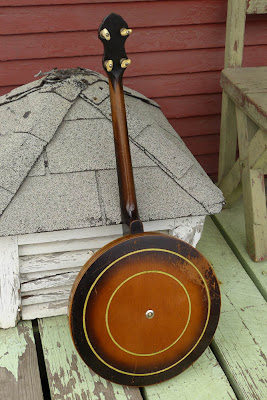c.1930 Oscar Schmidt "Delux" Tenor Banjo
I worked on this same model of tenor banjo in 2011 and this one is just as good as that one was. While there are no marks other than the gold-embossed "Delux" down the center of the headstock, this instrument was certainly made by Oscar Schmidt and the overall look of it apes some aspects of Gibson banjos while retaining the typical OS bluesy, funky charm.
Work included a fret level/dress, new Renaissance synthetic head, new bridge, cleaning, and setup. I also replaced a couple of missing hook/nut sets. It's setup for "Celtic" GDAE tuning and plays like a champ: fast 1/16" action at the 12th fret and a quick 21" scale which is ideal for melody playing.
Because of the way this banjo is built it has a loud, focused, but quite warm and woody tone to it. This is due to the non-tonering multi-ply maple rim mated to a full one-piece pot metal flange and heavy-duty resonator back. I tend to really like the sound of this setup as it's not so piercing and ringy as a big tonering instrument would have yet the resonator increases volume, projection, and clarity. It's a very "clean" sound with not a whole lot of cumbersome overtones.
Cool embossed "Delux" logo. As usual for an OS build, this sports Grover "Champion" friction pegs. The nut is celluloid, I believe.
All the wood on this instrument is maple and I believe this fretboard is, too, though of the "ebonized" variety. The frets are in good shape but low and small as typical for the period. The dots are celluloid rather than pearl.
The neck itself has a medium V shape which is quite comfortable and sturdy.
New Grover 2-foot ebony/maple bridge. Note the nice covered brass tailpiece, too!
The resonator shows some finish loss but looks great and fits very snugly with the flange. The striping is inlaid gold-sparkle celluloid which looks tres cool.
The 2-tone sunburst is pretty fun.
"Under the hood" is a hammer-into-place metal neck brace (a good design as it tightens further with a set-screw) and a slightly-off-center dowel that was (previously) adjusted to fit true by the addition of a bracket mount for it.
The friction pegs work just fine. Note how much finish has been played right off the back of the neck! Someone obviously played this a bunch.
The hardware shows some tarnish and (on the hooks) some rust spots, but it's overall in good shape for a banjo of this age.














Comments